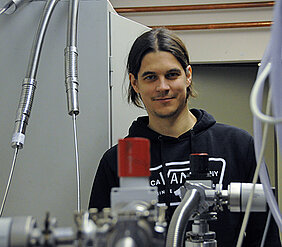ERC Grant for Christian Schneider
04/20/2016Physicist Christian Schneider (34) studies promising materials for novel lasers and quantum light sources. The European Research Council has awarded him 1.5 million euros to pursue his work.

Developing more powerful computers, solar cells or lasers: That is the goal of many research groups around the globe. For around five years, the scientific community has focused on the material class of transition metal dichalcogenides, among others. These substances are made of molybdenum or tungsten, for example, complemented by the elements sulphur, selenium or tellurium, respectively.
These materials are interesting for a number of reasons. Reasonably priced, they are relatively easy to prepare in extremely thin and stable layers that consist of a single layer of atoms and have semiconducting properties – making them an ideal material for optoelectronics.
"We want to find out to what extent the materials are suitable for optoelectronics and quantum photonics, and in particular for investigating novel laser-like light sources," says Dr. Christian Schneider. The physicist from the Julius-Maximilians-Universität (JMU) Würzburg in Bavaria, Germany, receives huge financial support for this venture: The European Research Council (ERC) funds his "unLiMIt2D" project with 1.5 million euros in the form of an ERC Starting Grant.
Research team will grow
The grant is designed for excellent young researchers and will allow Schneider to add two doctoral students and one postdoc to his team. But also undergraduate students of physics and nanotechnology can contribute to the project and write their bachelor or master thesis under the supervision of Schneider, for example.
What is the physicist's ultimate goal? "We will try to build a laser-like prototype," he explains. Their aim is to develop not a standard laser, but a polariton laser that may consume much less energy. Such kind of devices are maybe even more interesting from a fundamental point of view, since they share many similarities with Bose-Einstein condensates in solid state.
The Würzburg physicists already built a polariton laser in an international project which they presented in "Nature" in 2013. The next years will show whether polariton lasers can also be implemented on the basis of transition metal dichalcogenides.
Curriculum of Christian Schneider
Christian Schneider is from Karlstadt nearby Würzburg. After graduating from secondary school, he joined the University of Würzburg in 2001 to study nanostructural engineering. He spent one year at the University of Vancouver in Canada as an exchange student.
He graduated in 2007 and continued directly with his doctoral thesis in Würzburg: He studied the optical properties of nanostructures and semiconductors which he manufactured in the university's cleanroom at the Chair of Technical Physics. Having received his PhD in 2012, he took charge of the spectroscopy group at the Chair of Technical Physics. The young researcher is networked around the globe and his team cooperates with numerous research groups on four continents.
Contact
Dr. Christian Schneider, Chair of Technical Physics, JMU, Phone +49 931 31-88021, christian.schneider@physik.uni-wuerzburg.de
Web links






